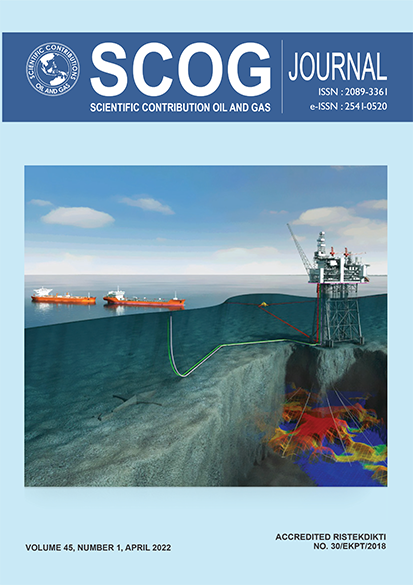The Feasibility Study of Reservoir Geomechanics from Brittleness Evaluation
DOI:
https://doi.org/10.29017/SCOG.45.1.920Abstract
A detailed understanding regarding the rocks Brittleness Index is helpful in oil and gas exploration as upfront information to determine the rock fracture gradient. Researchers have proposed several methods to estimate the rock Brittleness Index. However, different ways may yield different results and lead to varying interpretations regarding the Brittleness Index classifi cation. This paper evaluates the Brittleness Index of an Indonesian gas well using three approaches based on the elastic properties log data, elastic properties rock physics modeling, and mineralogical rock physics modeling to assess the consistency of the methods. The results obtained in this study suggest that elastic properties-based and mineralogical methods produced a consistent Brittleness Index. However, the vertical resolution is different. It indicates that the Brittleness Index estimated from the actual log data showed higher resolution than the Brittleness Index calculated from the rock physics modeling. Combining TOC data with the Brittleness Index is recommended to optimize hydraulic fracturing design and planning. For further investigation, the authors will be suggesting direct sampling from cores and laboratory measurements to obtain the in-situ mechanical properties of shale rocks.
References
Altamar, R. P. & Marfurt, K., 2014. Mineralogy-based
brittleness prediction from surface seismic data.
Application to the Barnett Shale. Interpretation, 2(4),
p. T1-T17.
Berryman, J. G., 1995. Mixture theories for rock properties.
Rock physics and phase relations. A handbook of
physical constants. 3rd ed. Livermore, CA: University
of California.
Göktan, R. M., 1991. Mining Science and Technology.
Brittleness and Micro-Scale Rock Cutting Effi ciency.,
(3), pp. 237-241.
Grieser, W. V. & Bray, J. M., 2007. Identifi cation of
Production Potential in Unconventional Reservoirs.
Oklahoma City, Oklahoma, U.S.A, SPE Production
and Operations Symposium.
Hucka, V. & Das, B., 1974. Brittleness determination of
rocks by different methods. International Journal of
Rock Mechanics and Mining Sciences & Geomechanics
Abstracts, 11(10), pp. 389-392.
Jarvie, D. M., Hill, R. J., Ruble, T. E. & Pollastro, R.
M., 2007. Unconventional shale-gas systems: The
Mississippian Barnett shale of north-central Texas
as one model for thermogenic shale-gas assessment.
AAPG Bulletin, 91(4), p. 475–499.
Mavko, G., Mukerji, T. & Dvorkin, J., 2020. The Rock
Physics Handbook. Cambridge: Cambridge University
Press.
Russell, B. H. & Smith, T., 2007. The relationship
between dry rock bulk modulus and porosity - An
empirical study: CREWES Research Report.
Russell, B. & Lines, L., 2011. A Gassmann consistent
rock physics template: CREWES Research Report.
Wang, F. P. & Gale, J. F. W., 2009. Screening criteria for
shale-gas systems. Gulf Coast Association of Geological
Societies Transactions (GCAGS Transactions),
p. 779–793.
Ye , Y., Tang , S. & Xi , Z., 2020. Brittleness Evaluation in
Shale Gas Reservoirs and Its Infl uence on Fracability.
Energies, 13(2), p. 388.
Zhu, Y., Xu, S., Payne, M., Martinez, A., Liu, E.,
Harris, C., & Bandyopadhyay, K., 2012. Improved
rock-physics model for Shale Gas Reservoirs. SEG
Technical Program Expanded Abstracts 2012, pp. 1-5.
Downloads
Published
Issue
Section
License
Copyright (c) 2022 SCIENTIFIC CONTRIBUTIONS OIL AND GAS (SCOG)

This work is licensed under a Creative Commons Attribution 4.0 International License.
Authors are free to Share — copy and redistribute the material in any medium or format for any purpose, even commercially Adapt — remix, transform, and build upon the material for any purpose, even commercially.
The licensor cannot revoke these freedoms as long as you follow the license terms, under the following terms Attribution — You must give appropriate credit , provide a link to the license, and indicate if changes were made . You may do so in any reasonable manner, but not in any way that suggests the licensor endorses you or your use.
No additional restrictions — You may not apply legal terms or technological measures that legally restrict others from doing anything the license permits.














